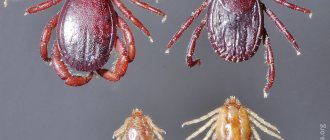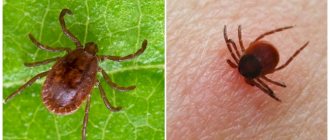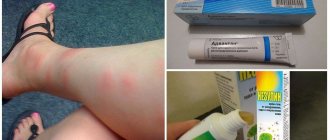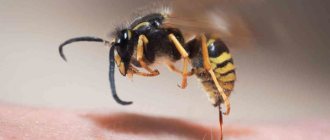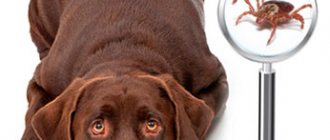The real scourge of any four-legged friend is ticks. Finding a parasite in thick fur is not so easy; you need to carefully examine the area behind the ears, neck, stomach and paws. The situation is simpler with short-haired breeds - their fur bristles at the site of the bite, and it is not difficult to detect the parasite. Often, owners are faced with the fact that their dog is left with a lump after a tick bite. A lump may also appear if the parasite has not been detected. Perhaps he had already had his fill of blood and fell off.
Since the pet’s tumor becomes red and impressive in size, this situation frightens caring owners. In most cases, there is no reason to panic. But you shouldn’t let things take their course either. The reasons for the appearance of compaction are very different. It is worth figuring out why, after removing the tick, the dog still has a lump and what needs to be done in this case.
Why might a lump appear?
If after removing the tick the dog is left with a small lump, this is the body’s natural reaction to a foreign body. The reasons for the appearance of a lump after an insect bite are:
- Allergy.
When the parasite bites through the skin and attaches itself, it immediately injects saliva into the wound. Often it is the local allergic reaction that occurs to the secreted secretion of saliva that is the cause of the appearance of the tumor. As a rule, this is a small tumor and does not cause any particular problems. The dog's behavior does not change, and there are no health problems. The structure of the neoplasm is dense and hard, the tumor turns red and itches. The fur in this area may bristle, fall out, or change color. - Intoxication of the body.
If the insect was removed incorrectly, particles of the parasite may remain in the animal's body: paws or head. Then an inflammatory process begins at the site of the wound, which leads to the appearance of a neoplasm or even suppuration. The tumor appears within a few days after the bite, gradually grows and significantly increases in size. If suppuration appears, the formation turns red and becomes quite large in size - about the size of a walnut. Touching it is painful, the animal behaves restlessly. - Infection.
Sometimes the dog itself introduces the infection by scratching the damaged area. In severe situations, this is fraught with the development of an abscess, which requires surgical intervention. The lump becomes red in color, increases significantly in size and causes pain in the animal. Symptoms of this condition are fever, lethargy and decreased activity of the dog, and loss of appetite.
Most often, a lump in a dog at the site of a tick bite is caused by a common allergic reaction; less often, it is the cause of infection. But if a loving owner has doubts, it is necessary to show the pet to a doctor.
Why you should be wary of ticks
Ticks are a parasite that becomes more active during the warm season. A tick is a spider-like creature that feeds on the blood of an animal or person. A tick that has already drunk blood looks like a hanging mole or a dark pea.
It is very important to detect ticks on a dog’s body in time, as they can carry serious diseases, such as:
- babesiosis (pyroplasmosis);
- hepatozoonosis;
- spotted fever;
- borreliosis;
- bartonellosis;
- skin diseases;
- neurointoxication;
- various infectious diseases.
Half of the listed diseases are dangerous for humans, including.
The animal's body reaction to a bite
If a tick is found on your dog's skin, it must be removed immediately. It is recommended to do this carefully, making sure that no parts of the parasite remain at the site of the bite. If you have no experience in removing ticks, it is better to consult a veterinarian.
After removing the parasite, it is advisable to submit it for examination to determine whether it is a carrier of the infection.
In any case, a lump remains on the skin after a tick bite on a dog. This is due to the following reasons:
- allergic reaction to anesthetic secretion;
- infection;
- intoxication due to the remainder of the body part of the parasite under the skin.
Allergy to tick bite
The safest consequence is that after a tick bite, the dog is left with a lump to the touch that resembles a small tissue compaction. This is an allergy to the chemical composition of the tick secretion. When pressed, this seal does not cause pain, generally does not affect the activity of the animal, and can only occasionally cause itching.
The only negative is the disappearance time. It can take up to six months. Sometimes the fur may fall out at the site of the bump or its color may change.
What to do if your dog gets a lump after a tick bite
If after a walk a parasite is found on the animal’s body, it must be removed. Removal is carried out carefully so as not to leave insect body parts under the dog’s skin, since they can cause a tumor to appear and infect the animal. If the extraction is carried out correctly, the wound is treated with hydrogen peroxide. A lump after a tick bite in a dog does not require immediate treatment. The pet needs to be closely monitored for 14-21 days. During this time, the pet should:
- Measure body temperature 1-2 times a day;
- provide enough fluids and nutrition;
- monitor your diet - the amount of food you eat should not decrease;
- record decreased activity, unsteadiness of gait, or other changes.
The allergic reaction has a local location and does not affect the general condition of the four-legged animal. Weakness, fever and deterioration are most likely an indicator of infection.
Local reactions to a tick bite
So, fortunately for everyone, the parasite turned out to be “healthy” and the pet showed no symptoms of viral infection, but after the tick bite the dog developed a lump. There may be several reasons:
- The head or paw of the tick remained under the dog’s skin - the immune system began to reject the foreign protein and a slight swelling appeared. Monitor the condition of the skin, the parasite's paw may dissolve, the head will most likely cause suppuration. The lump may not form immediately and may have the appearance of a cone - the deep tissues of the epithelium are renewed, pushing the foreign object upward. There is no need to smear, cauterize, or heat; if possible, consult a doctor. If the specialist deems it necessary, he will open the skin and eliminate the source of inflammation.
- Abscess - can begin if the head of a tick remains in the dog’s skin or the pet scratches the lump and introduces an infection into the wound. The lump has a red or bright pink color, gradually increases in size, the local skin temperature rises, and the dog shows anxiety when palpated. Either see a doctor right away - the best option - or wait until the abscess reaches a stage where it can be opened. Against the background of inflammation, the dog may have a fever and weakness.
How to properly treat a lump after tick removal
If the lump at the site of a tick bite on a dog does not cause concern, and the animal’s condition has not worsened, there is most likely nothing to fear. Depending on the cause of the tumor, the animal is given assistance:
- If the lump is caused by an allergic reaction, treatment of the formation is not required; most often, it disappears on its own over time. Depending on the severity of the allergy, the neoplasm does not disappear within 6-12 months.
- In the event that the head of an insect remains in the dog’s body, the help of a doctor will be needed. In the clinic, the doctor makes an incision at the site of the tumor, removes the foreign body and treats the wound.
- If inflammation occurs due to infection, suppuration may develop at the wound site. In this case, it is necessary to show your pet to a veterinarian.
In severe cases, surgery and subsequent antibiotic therapy will be required to remove the abscess.
Treatment of a bump from a tick bite
If your dog still has a lump after a tick bite, you need to take measures to eliminate it. A normal lump that does not cause pain will go away in 3-6 months. In its place, some hair may fall out. The entire healing process must be constantly monitored and ensure that the dog does not scratch this area.
Lumps in cats should also be supervised by the owner. If it does not go away for a long time or festeres, the cat should be taken to the veterinarian.
Any remaining particles, such as paws or small pieces of jaws, should resolve on their own. The head and other large parts will cause prolonged inflammation. Scratched sores can also cause pain to the animal and provoke it to scratch again. The wound needs to be washed and treated with brilliant green.
Lump after a tick bite on a dog
If the lump after a tick bite on a dog does not go away and festeres even more, you need to take your pet to a veterinary clinic. There, the doctor, under anesthesia, removes the pus and remnants of the parasite, treats the wound and prescribes antibiotics for speedy healing.
What not to do yourself
The most common problem is the inflammatory process and the appearance of suppuration. It is not recommended to carry out treatment on your own, as this can seriously harm the dog. A few rules of what you should never do:
- Squeeze out pus from the tumor. This is fraught with infection in the blood and the subsequent development of sepsis.
- Open the seal yourself. The reason is the same - infection of the wound.
- Prescribe and apply ointments yourself, use compresses. Incorrectly selected medications can increase irritation and itching and cause burns.
- Warm the seal. If pus has formed in the wound, heating is strictly prohibited. This procedure can trigger its entry into the blood.
Neoplasms can be of a different nature and appear as a result of other diseases, even if the symptoms are similar.
Prevention
Tick bites can cause trouble, even in the absence of dangerous infections. Cones after removing a tick from a cat or dog require increased attention from owners. To avoid such problems, it is easier to worry about how to protect your pets from arthropod parasites.
There is a large selection of products for dogs that repel bloodsuckers during walks. They are produced in the form of drops, tablets, collars, sprays. Each product has a long-lasting effect and does not cause any discomfort to the pet. The exception is the components of these acaricidal agents, to which the animal may be allergic.
Types of formations and their features
Under the influence of such factors, a lump may appear immediately after the bite or for some time, even after the wound has healed. If a lump from a dog bite does not go away for a long time, you should definitely consult a doctor. If you delay, more serious consequences may develop.
Let’s take a closer look at what consequences a person bitten by an animal most often faces:
- Hematoma. Subcutaneous or intramuscular hemorrhage occurs when small blood vessels rupture. Blood accumulates in the resulting cavity; further fluid stagnation can lead to suppuration.
- Abscess. When foreign bodies, pathogenic microorganisms, or infection enter the tissues, an accumulation of pus can form. As the process progresses, there is a risk of developing sepsis.
- Scarring. Connective tissue forms at the site of injury. The lump appears due to hypertrophic processes, when excess newly formed tissue appears above the surface of the skin.
- Callus. At the site of bone damage, new tissue begins to form. Initially, it differs in its density and properties, and an osteoid callus appears. Over time, the bone is restored if appropriate intervention is provided.
- Post-traumatic fibroma. It is a benign neoplasm of fibrous connective tissue. Most often, this type of fibroma is dense in structure and does not differ in color from the skin. There is a hereditary tendency to such processes.
- Allergic reaction. Swelling is a response to the entry into the body of irritant substances that provoke the production of histamine. It may also be a consequence of topical use of inappropriate medications.
How should you treat spots and bumps after tick bites?
The main measure is to apply topical products with antiseptic and antibacterial properties, which will avoid secondary infection.
Additionally, medications may be prescribed:
- antipruritic;
- anti-inflammatory;
- antihistamines;
- containing anesthetic.
Examples of drugs: Psilo-balm, Elokom, Advantan, Fenistil, Vishnevsky ointment, Chlorhexidine.
Topical and oral medications for tick bites
Warnings and prohibitions. What is prohibited to do when the tubercle is swollen and suppurates?
If you behave incorrectly when a lump remains on the skin after a tick attack, there is a risk of complications.
Recommendations to avoid this:
- if you try to squeeze pus out of inflamed tissues, the risk of spreading the abscess contents further into the tissue will increase, which can contribute to blood poisoning;
- when inflammation develops, it is prohibited to warm up the tissues, so appropriate procedures are not carried out, and the use of warming ointments is avoided.
You need to see a surgeon to clean the affected area. If an abscess has formed, it is opened under local anesthesia.
Seeing a doctor if a tick bite becomes infected or inflamed
Why do bumps appear?
Compaction occurs when the outer coverings of the human body are damaged. This is a tissue reaction, since in order to obtain food the parasite chews the skin and then gets caught in the wound through the teeth; for this it needs to insert a proboscis.
From the outside it seems
that such actions do not have a significant effect, since a minimal area of tissue is affected.
However, in fact, the skin is severely injured, which is due to a number of processes:
- skin incision;
- impact of many teeth;
- insertion of the proboscis and then the head into the wound, since the length of the oral apparatus is often not enough to reach the blood vessel.
When tissue is damaged, infiltrate accumulates under the skin. As a result, tension is created in the structure of the upper layer of the outer integument. As a result of this process, a seal occurs at the site of the tick bite. The exit for it is closed, since after removing the proboscis, the damaged tissues close, and the process of restoring the integrity of the skin begins. It is impossible to guess what the consequences will be (the lump will resolve on its own or develop into a neoplasm under the influence of external or internal causes).
Another reason for the formation of such a compaction is the development of dangerous diseases. The formation of the cone is partly facilitated by the process described above. In addition, pathogenic particles penetrate the body through injured tissue areas. They contribute to the emergence of a response in the human body and the development of inflammation. The reason is penetration into healthy cells, release of toxins.
In case of tissue damage
Infiltrate accumulates under the skin.
Development of a bump from a tick bite on the skin




